ASUS VivoBook 14 M413U Review
If you are looking for a laptop that is not only used during the pandemic, but for future work, you can take a look ASUS VivoBook 14 M413U. You see, this laptop is not only powered by a processor AMD Ryzen 7 5700U which is pretty tight. This laptop also has a very long battery life.
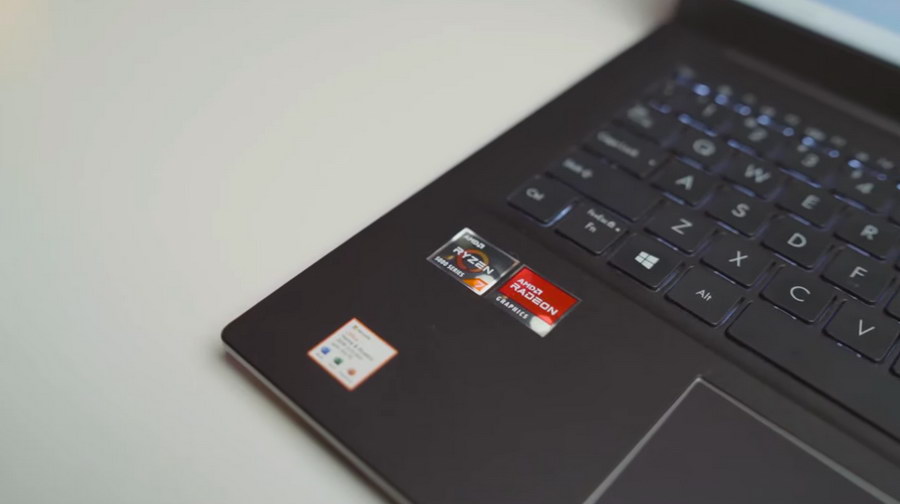
Using processor-based AMD Ryzen 5000 U SeriesThis processor uses a 7nm architecture which not only has fast performance, but also saves power consumption. Especially AMD Ryzen 5000 U series is the only x86 processor that has 8 cores and 16 threads with a TDP of 15 watts. This solution is also quite good for laptops with thin dimensions and makes the increase in battery life last longer.
In addition, this processor also has an integrated GPU that is faster than the previous generation. So you can get a cheaper price than having to look for one that uses a discrete GPU. In addition to these advantages, this laptop also has several other things that are no less interesting. But first, let’s take a look at the specifications from the following table.
Specification Design
Design
Like other laptops in the same class, the cover of this laptop is plain and minimalist. The unit we are reviewing this time has a black cover color, with the ASUS VivoBook logo in the middle right. The cover has a metallic coating which is a bit rough to the touch. Fortunately this layer is not easily dirty with fingerprints when we touch it.
To open this laptop, we need two hands, one to open and one to hold the body. In fact, the hinge has a size that is quite long. The color of the inside is still the same as the cover. However, ASUS uses doff plastic material in the palm rest area and plastic with a slightly rough coating on the screen bezel.
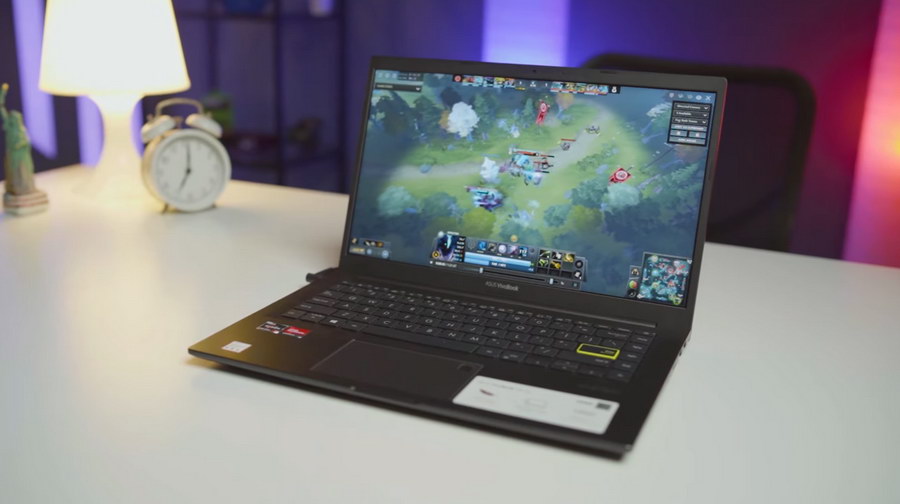
Turning to the screen bezel, the left and right sides are thinner than the top. But this is natural because they have to store the camera and microphone on the top bezel.
As for air circulation, there are no air holes on the left and right sides of the laptop. The position of the air hole is only between the longitudinal hinges. And as usual, at the bottom there is a small intake hole, with a total of three positions at once. ASUS seems to be quite comfortable using minimalist air holes due to the use of low-power U-series processors.
Dimension
For a laptop with a 14-inch screen, the dimensions are arguably not too big. It is 32.4 cm long and 21.5 cm wide. As for thickness, it’s also quite thin, although not the thinnest. ASUS claims the thickness of this laptop is around 1.79 cm.
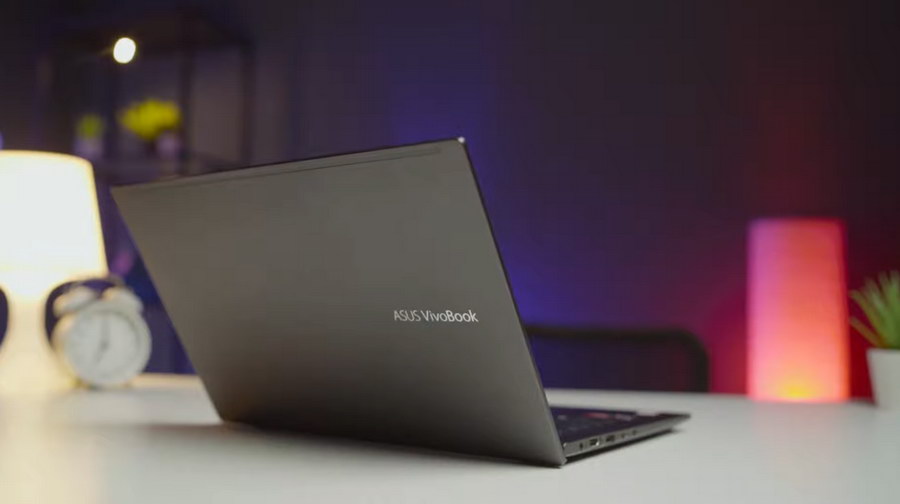
For its weight is also fairly light, namely 1.4 kg wrote. It’s still very comfortable to carry and fits perfectly in a medium-sized bag.
Screen
The laptop screen on this laptop uses an IPS panel. So, the viewing angle of this laptop is wide enough so that it remains clear when viewed from various sides. The screen resolution is full HD with an aspect ratio of 16: 9 and has a refresh rate of 60 Hz. The panels are anti-glare, so if you use them outdoors, light reflections or shadows won’t be too distracting.
Based on information from Hwinfo, the screen uses a panel made by Chi Mei. And regarding the specifications we managed to get using Spyder, the color gamut was recorded in the range of 63%, sRGB, 45% NTSC, and 47% AdobeRGB.
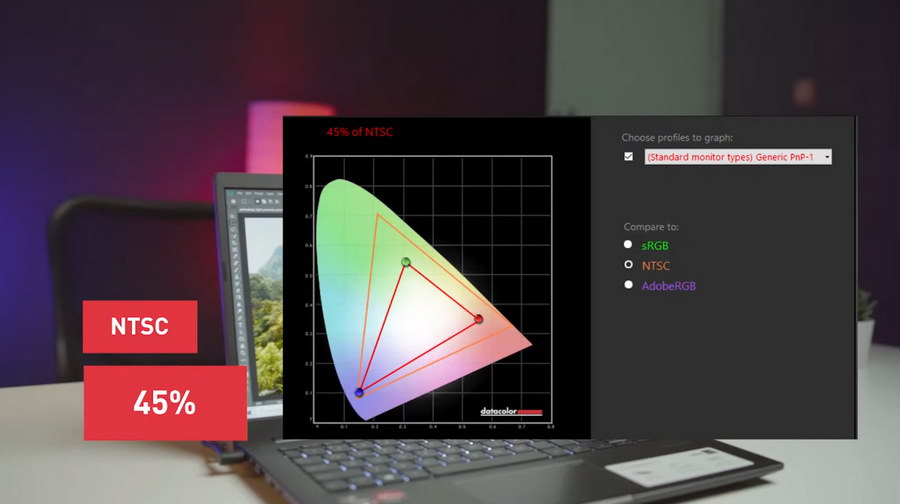
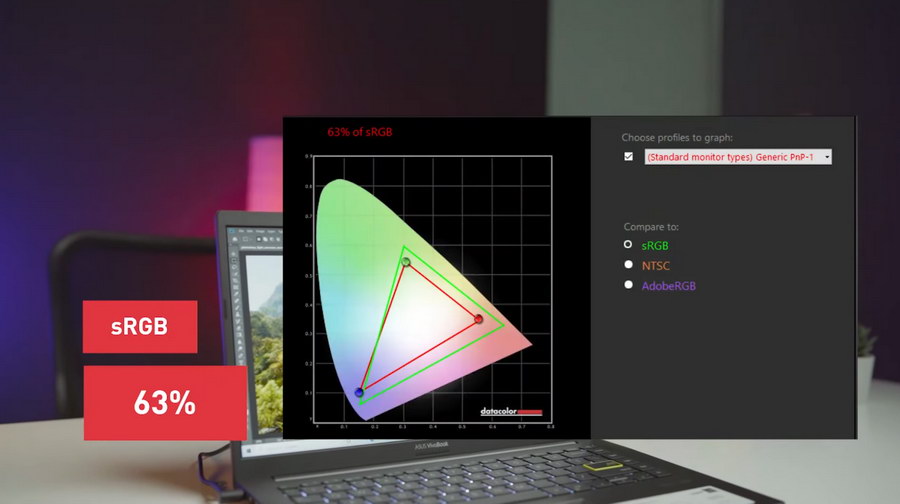
The color gamut is not very wide, so it is not suitable for professional content creation activities. But if it’s used to watch movies or play non-competitive games, then a screen like this is decent enough to use.
Keyboard
The keyboard on this laptop has a white backlight with three brightness levels. There are also indicators on the keyboard so that it will be easier for most users. The distance between the keys is rather narrow and has a key travel of 1.4 mm. For the feel of typing it is normal and needs a little adaptation, especially for those who are used to using laptops with larger keyboards.

Unfortunately, the Power button is attached to the keyboard, so if it is accidentally pressed, the laptop will automatically go to sleep mode. You can configure yourself for this option that has been provided on Microsoft Windows
Touchpad and Fingerprint
The touchpad on this notebook has a small size with a slippery surface without a dedicated button. The feel of using the touchpad is also normal because the left and right clicks are a bit hard. Fortunately this touchpad already supports Windows Precision Driver, so it can be used up to 4 fingers and has the option to turn off the touchpad function when the mouse is attached.
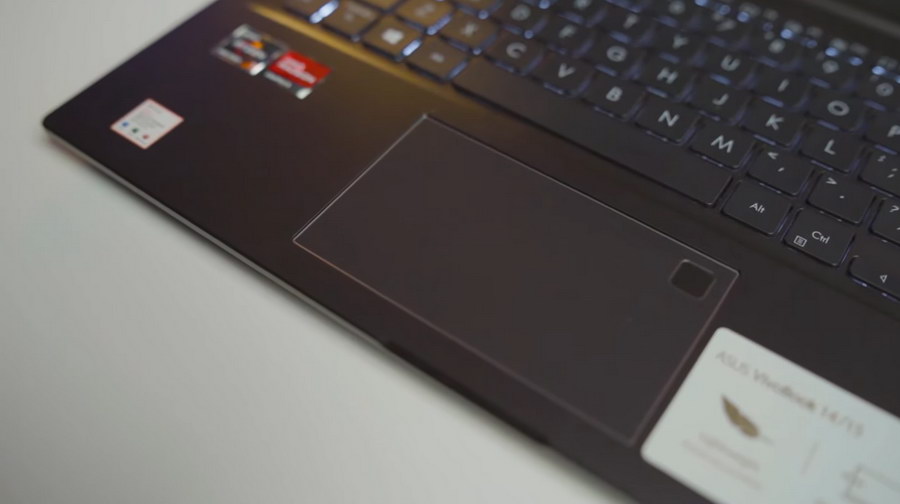
Interestingly, ASUS places the fingerprint sensor in the upper right area of the touchpad. Has box dimensions, the size is just right for the index finger. This sensor is of course useful to provide additional protection when trying to log into Windows. The response was good and smooth.
Webcam & Microphone
The webcam & microphone that ASUS provides have fairly standard specifications. The webcam can record videos with a maximum aspect ratio of 16:9 with 720p resolution with a frame rate of 30 FPS. In our opinion the results from the webcam are quite standard in sufficient lighting. As for the results from the microphone, it’s also not bad, when the noise cancellation feature is turned on, the sound becomes louder even though the noise is not heard.
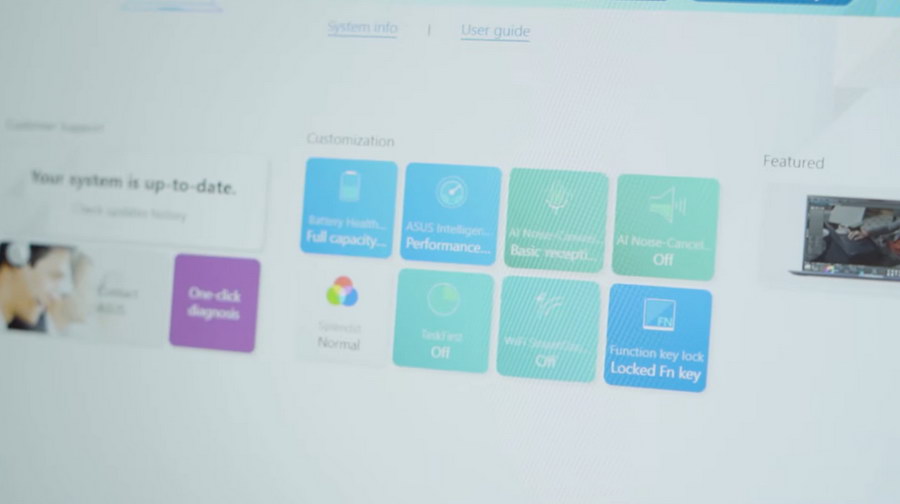
Oh yes, the webcam and microphone settings can be done through the default software, namely MyASUS. For further explanation, we will discuss later.
Battery
ASUS embeds a battery whose capacity is quite standard, which is around 42 Watt Hour. And when the CPU combination is Low Power, the battery life should be quite good. To find out how long the battery lasts, we did a test using PCMark 10 Modern office software.
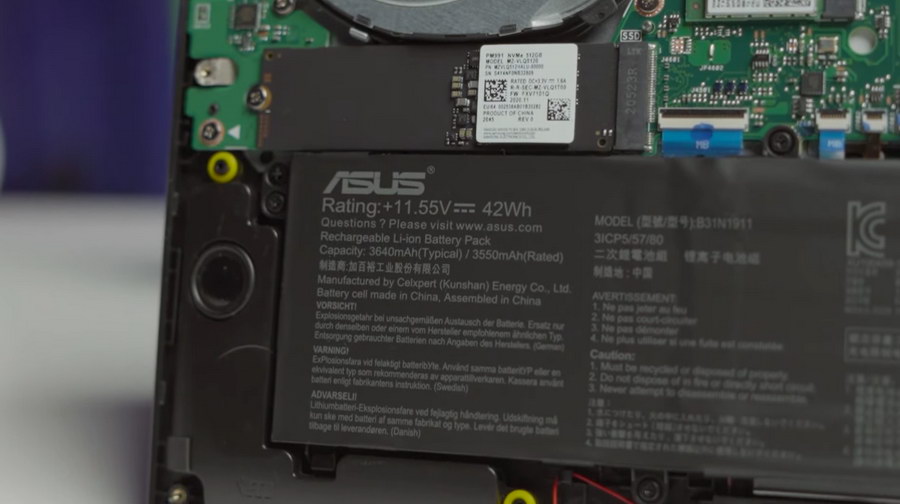
We also enabled power saving mode, WiFi was turned on, and LCD brightness was set to 50%. Based on the tests we did, this laptop was able to last for 12 hours and 22 minutes. That’s a long time for a battery with that capacity. Great.
I/O Port
For port availability, in a fairly affordable price range, the VivoBook 14 M413U in our opinion is quite complete. On the left side there is one DC-In, one HDMI Port, one USB 3.2 Type A, one USB 3.2 Type C, and a Combo Audio Jack. While on the right side there are two USB 2.0 Type A, and a Micro SD Card Reader.
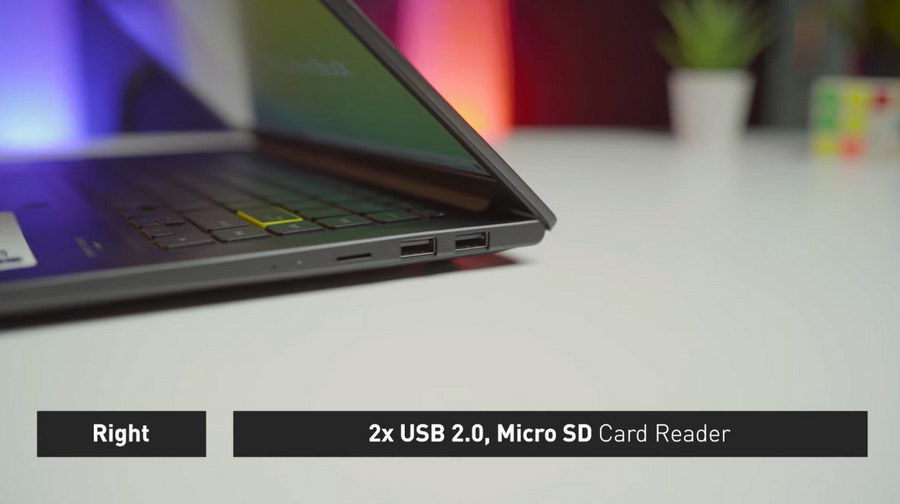
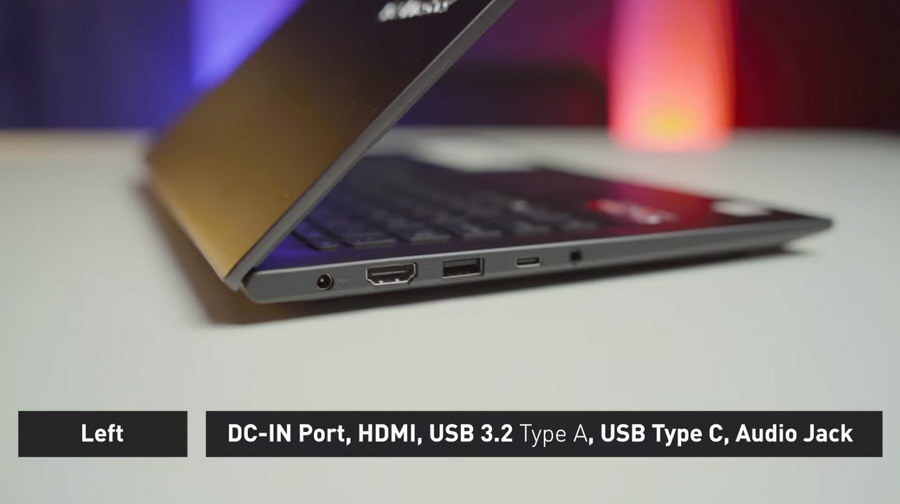
For its wireless connectivity, it is equipped with an Intel Wi-Fi 6 AX201 WiFi card and Bluetooth 5.0. So in terms of connectivity, we have absolutely no complaints.
Storage
ASUS provides an M.2 NVMe SSD with a capacity of 512gb. Meanwhile, in terms of speed, the SSD has a standard read & write speed. However, if it is used for daily activities, the storage speed of this laptop is far more sufficient than the hard drive.
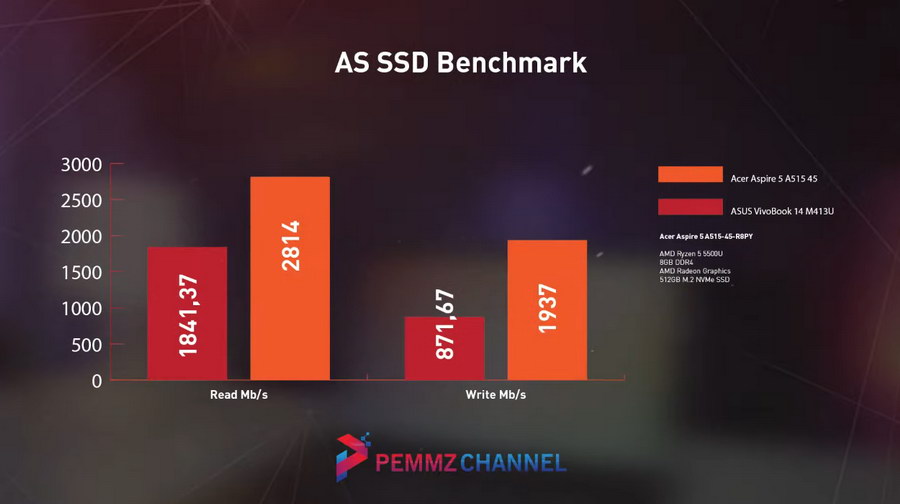
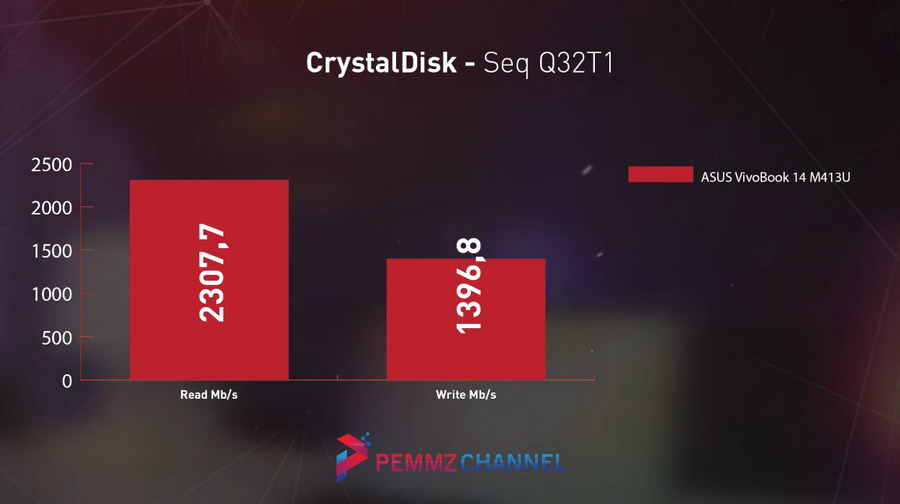
Upgradeability
ASUS still provides an option for upgrading in the storage sector by providing an empty M.2 SSD slot. so you don’t need to disassemble the default SSD from this laptop. Meanwhile, the RAM slot is not available and this laptop only uses soldered RAM.
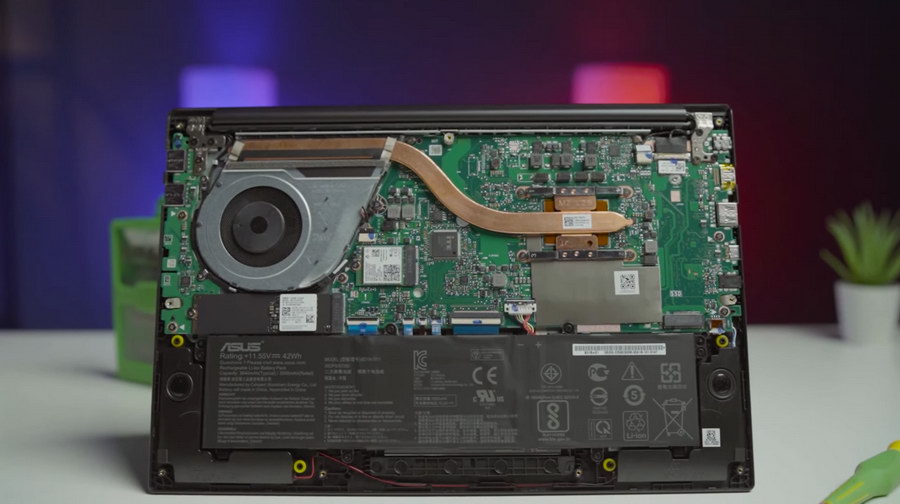 Audio
Audio
For speakers, this laptop has speakers down firing at the bottom of the left and right sides. In our opinion, this laptop speaker has a pretty loud sound. ASUS also added DTS Audio Processing software to improve the sound quality. Inside, there are preset modes consisting of music, movies, games, custom audio and graphic EQ.
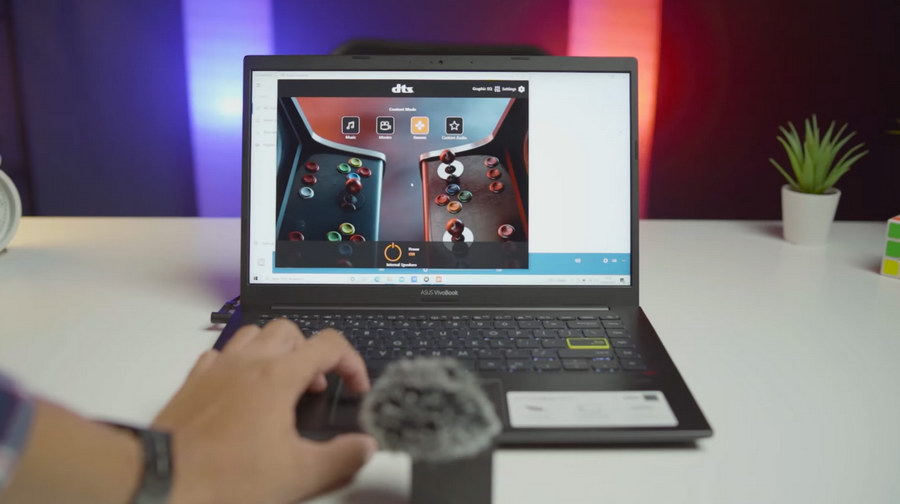
For audio quality, the bass sound is still quite pronounced and the treble sound is also not shrill. So pretty good if used for multimedia activities.
Software
At the beginning of this video, we mentioned that there is MyASUS built-in software on this laptop. It contains various features such as Battery Health Charging, Power Mode, Splendid, Function Key Lock, WiFi SmartConnect, ClearVoice Mic, ClearVoice Speaker, and TaskFirst. In addition, the My ASUS software also contains hardware information, checks for software updates, and performs system diagnosis.
Temperature
ASUS is only given one fan and one heatpipe whose path is unified for the CPU & GPU. When doing a stress test using AIDA64 for 15 minutes, this laptop did reach the highest temperature at 92 degrees Celsius and was stable at 90 degrees.
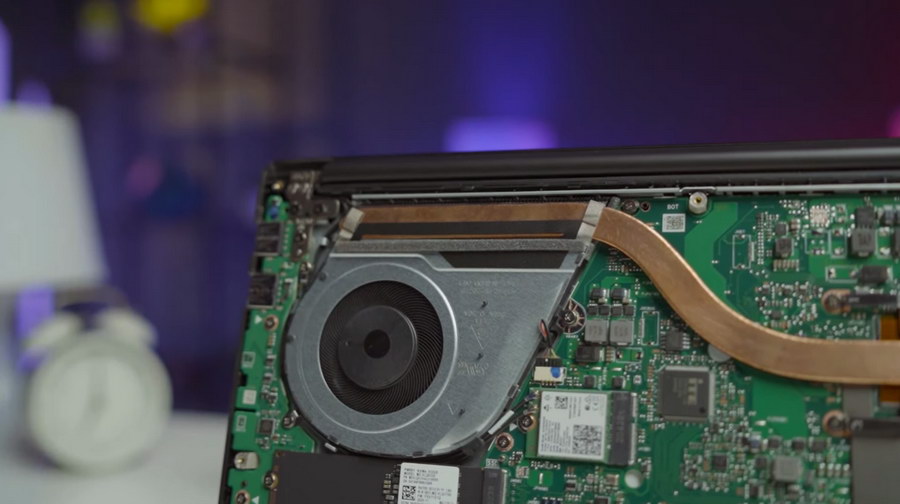
However, AIDA does not display a message of overheating or thermal throttling. So you could say this temperature is still relatively safe. Moreover, this stress test scenario rarely occurs in computing activities that are usually carried out on a daily basis.
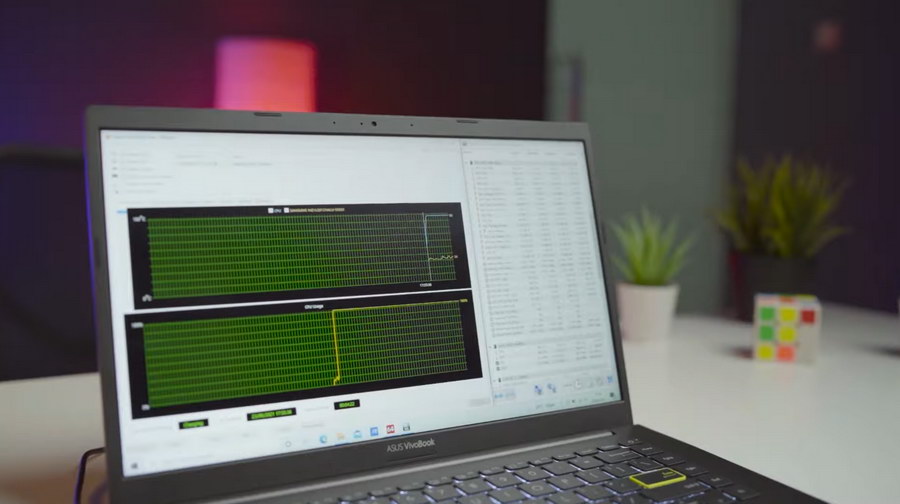
Performance
To measure performance, as usual we run several benchmarks that represent each of its components. In terms of CPU, VivoBook 14 is able to compete with Acer Nitro 5 which uses AMD Ryzen 7 5800H. Cinebench’s multicore and single-core scores are not much different. Even though the CPU is different class. As is known, the U series is a low-power processor line that lowers power, while the H series prioritizes performance.
The performance is also much higher than the Acer Aspire 5 which uses the Ryzen 5 5500U that we have tested before.
VivoBook 14 is also fast for editing photos and videos. 3D rendering tests such as PCMark 8, Adobe Photoshop Heavy & Adobe After Effects CC, have competitive scores with the two laptops we mentioned earlier. For heavier tasks such as rendering using a blender, 3Dmax or Maya, this laptop is still capable. However, the expectations should not be too high. For more details, you can see in the following table.
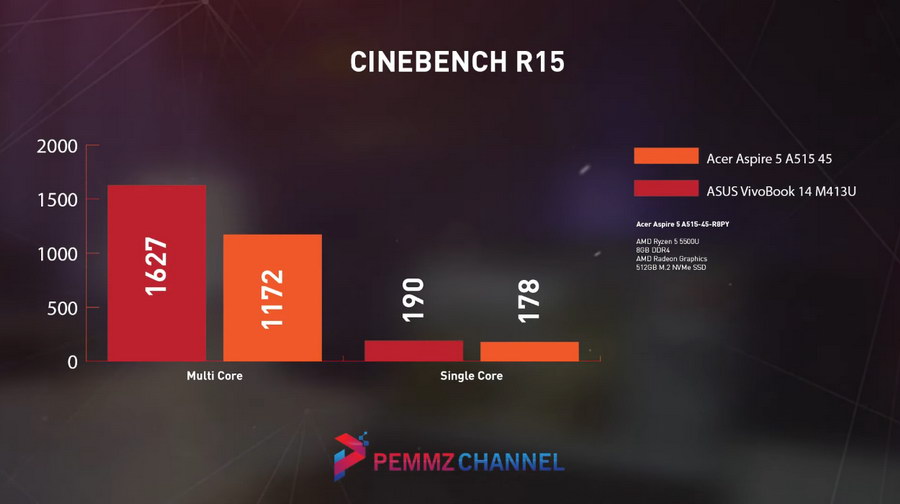
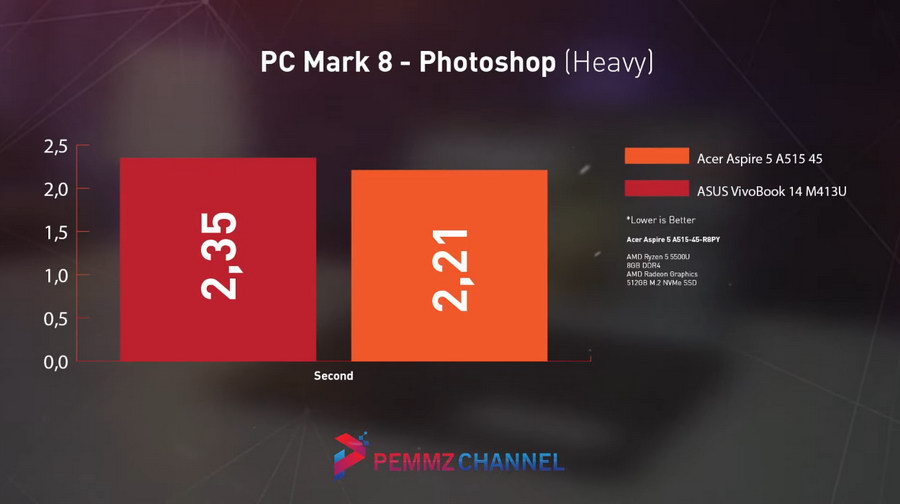
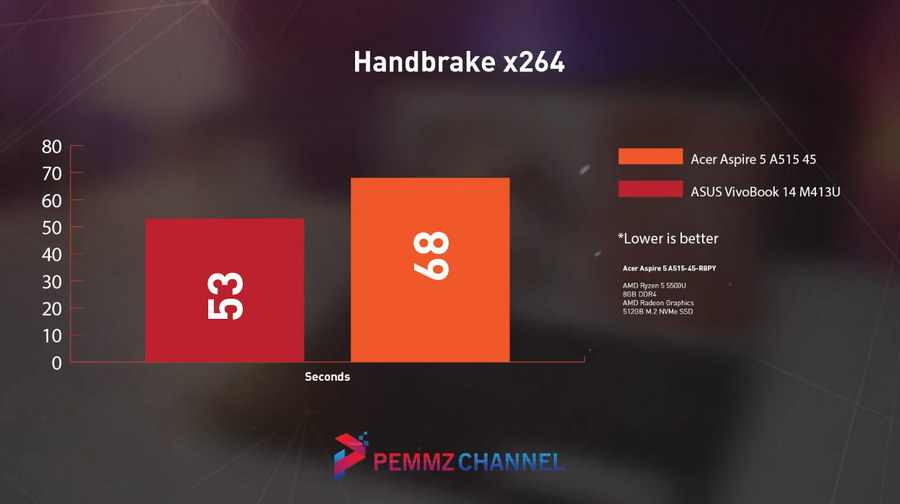
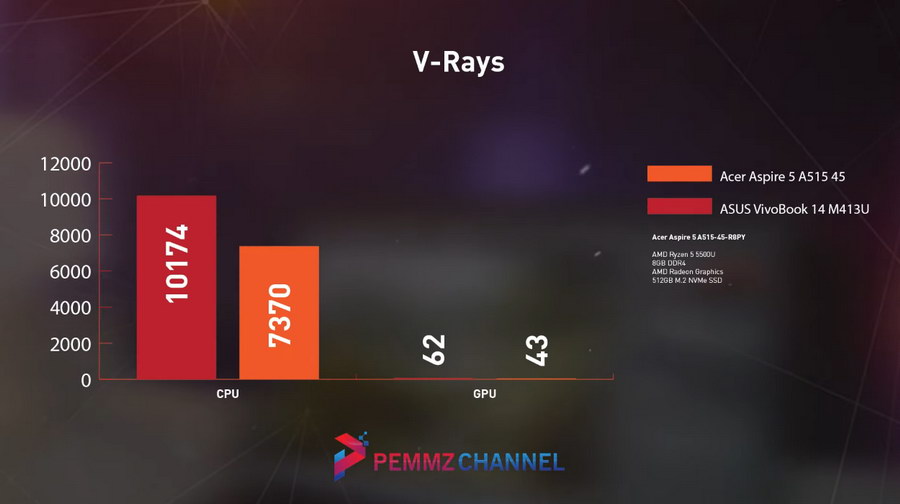
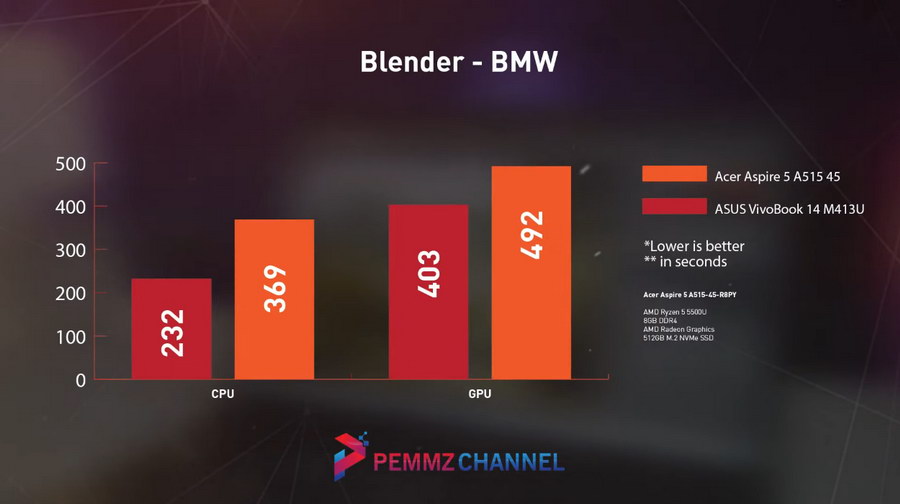
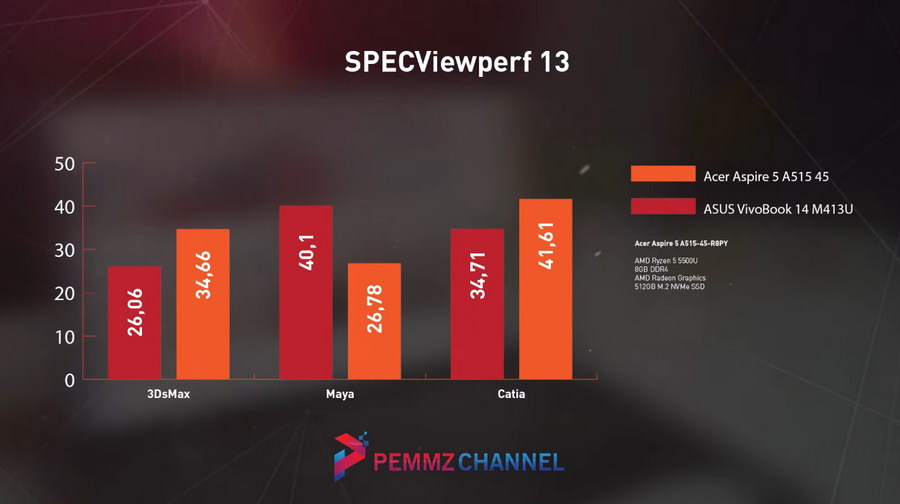 Especially for the GPU, this laptop uses Radeon Graphics which is the default graphics chip from the CPU. Although not specifically intended for gaming, in fact this GPU is still able to run light competitive games like CS: GO or Dota 2 smoothly. And even then with the choice of left-aligned graphic details. In our tests, CS:GO and Dota 2 can score 100s of fps. We also tried to run the heavier games, namely Shadow of the Tomb Raider and Far Cry 5. As a result, these two games only reached around 20 fps. This result is not bad for the onboard GPU. Because this GPU is not intended for playing heavy games.
Especially for the GPU, this laptop uses Radeon Graphics which is the default graphics chip from the CPU. Although not specifically intended for gaming, in fact this GPU is still able to run light competitive games like CS: GO or Dota 2 smoothly. And even then with the choice of left-aligned graphic details. In our tests, CS:GO and Dota 2 can score 100s of fps. We also tried to run the heavier games, namely Shadow of the Tomb Raider and Far Cry 5. As a result, these two games only reached around 20 fps. This result is not bad for the onboard GPU. Because this GPU is not intended for playing heavy games.
To see a more complete score, you can see from the following tables.
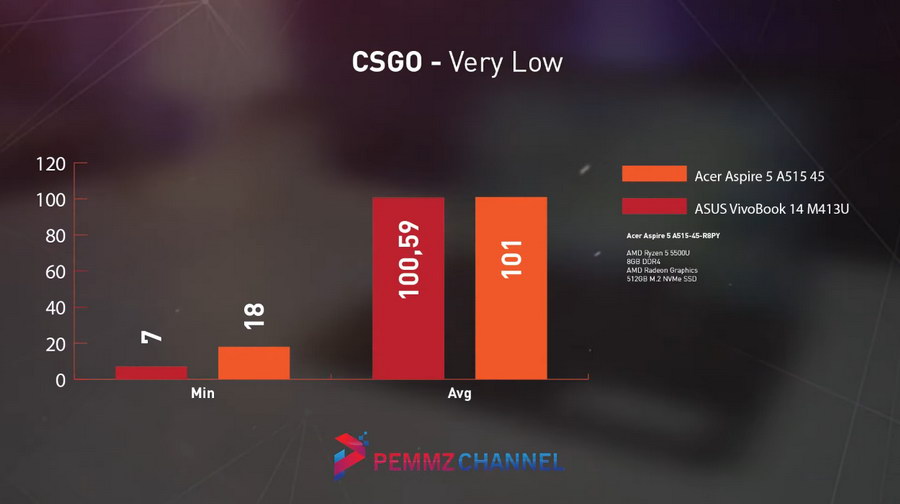
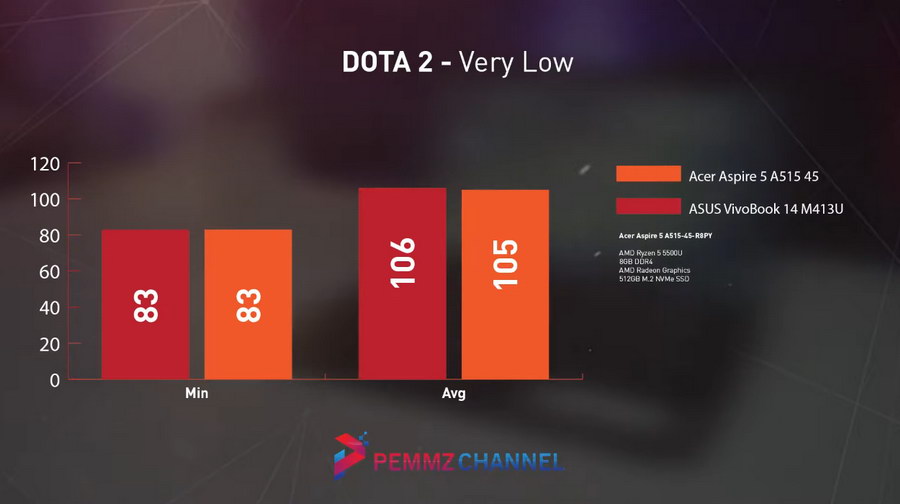 Conclusion
Conclusion
ASUS VivoBook 14 M413U can be a cool laptop to work with, do college or school assignments, to entertainment. For the price, the ASUS VivoBook 14 M413U is priced at Rp. 11,599,000. Expensive? We don’t think it’s too expensive. Because this laptop already uses the AMD Ryzen 5000 series processor. Not to mention other advantages such as a compact design, full HD IPS screen, complete I / O ports in its class, and long battery life which are quite good selling points.
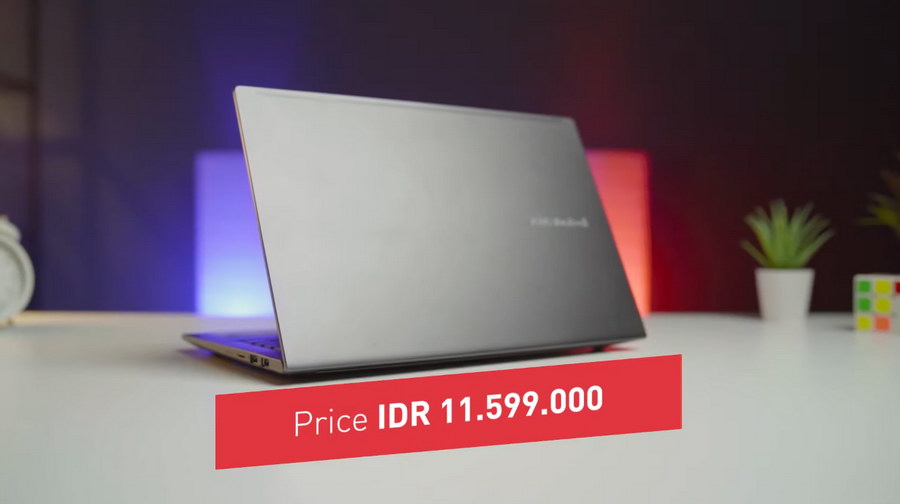
Even though there are drawbacks, it’s not too much of an obstacle. For example, such as the standard screen color gamut or RAM that cannot be upgraded, it doesn’t really matter. What is certain is that you adjust the specifications of the laptop to your needs.
Post a Comment for "ASUS VivoBook 14 M413U Review"